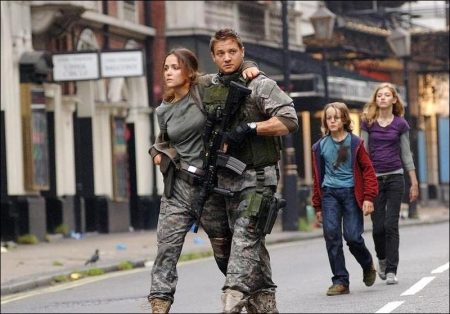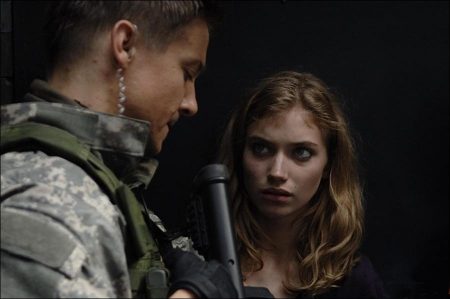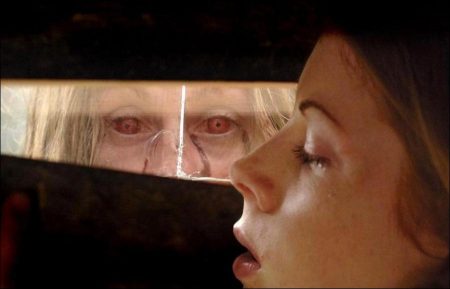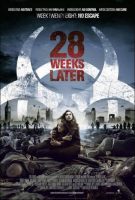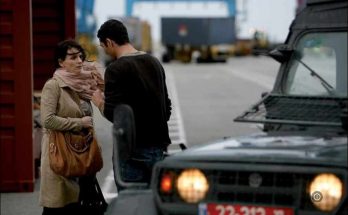Tagline: When days turn to weeks.
28 Weeks Later, the sequel to the 2003 international smash hit 28 Days Later, is directed by Juan Carlos Fresnadillo (Intacto) and produced by Enrique López-Lavigne, Andrew Macdonald and Allon Reich. 28 Weeks Later is an original screenplay by Rowan Joffe, Juan Carlos Fresnadillo, Enrique López-Lavigne, and Jesus Olmo; with Danny Boyle and Alex Garland serving as executive producers.
The cast is led by Robert Carlyle (The Full Monty, Trainspotting); Rose Byrne (Sunshine, Troy); Jeremy Renner (The Assassination of Jesse James, Dahmer); Harold Perrineau (The Matrix Reloaded / Revolutions, Lost); Catherine McCormack (Braveheart, Spy Game); Imogen Poots (V For Vendetta) and Idris Elba (The Wire). Also joining the cast is a talented young newcomer, twelve year old Mackintosh Muggleton making his feature film debut.
Four years after the enormous international success of 28 Days Later, the director / producer / writer team of Danny Boyle, Andrew Macdonald and Alex Garland felt the time was right to make a sequel. “We were quite taken aback by the phenomenal success of the first film, particularly in America,” recalls producer Andrew Macdonald. “We saw an opportunity to make a second film that already had a built in audience. We thought it would be a great idea to try and satisfy that audience again. The hard bit was to try and find a story which would live up to the power and depth that Danny and Alex brought to the first film.”
The first decision the filmmakers had to make was when should the sequel be set. Should the film involve the original cast? Should it go further into the future? Should it be a prequel? 28 Days Later told the story of when the virus was first unleashed following a raid on a primate research facility by animal rights activists. Transmittable in a single drop of blood, the virus locks those infected into a permanent state of murderous rage. Within 28 days the country was overwhelmed and a handful of survivors desperately struggled to salvage a future.
“Alex came up with a lot of ideas and eventually we agreed upon a concept about what would happen to the UK after the disease had been eradicated and the quarantine was lifted,” explains Macdonald. “What would happen if there were only 500 people populating the UK? Who would be there to organize the survivors and refugees coming back from overseas, and what would happen to the Brits who survived? All those questions seemed interesting to us and it was out of them that the story evolved”.
Screenwriter Rowan Joffe, who had previously written Gas Attack and Last Resort, was hired to craft a first draft of the script. The search then began for a talented young director who would have the flare to follow in Boyle’s footsteps as well as be able to bring a fresh new perspective and their own unique vision to the film. “We were looking for a filmmaker of some individuality who could bring something different to the film,” says Boyle. “London was such a big part of the first film we thought that getting somebody from outside the UK to come in and direct would be an interesting approach as they would give the Capital a fresh look.”
Boyle had recently seen the provocative thriller Intacto, the feature film debut from Spanish director Juan Carlos Fresnadillo which had been a huge international and critical success. “I thought Intacto was amazing,” recalls Boyle. “A terrific thriller with tremendous flare and energy, as well as being a highly individual piece of filmmaking. I recommended [Producer] Andrew Macdonald and [Executive Producer] Alex Garland go and see it with Juan Carlos in mind for taking the helm on 28 Weeks Later.”
After seeing Intacto Macdonald and Garland were also convinced that Fresnadillo was the director they were looking for, and the filmmakers approached him to direct 28 Weeks Later. They were thrilled when Fresnadillo and his Spanish producing partner Enrique López-Lavigne agreed to come on board.
Producer Allon Reich explains, “Juan Carlos and López-Lavigne, they’re a fantastic double act. Juan Carlos is very thoughtful, very much about the detail… While Enrique is a ball of energy, a film geek, and he’s seen every film of this type. And I think there’s definitely a yin and yang in their energy, and the way they approach life that leads to a very kind of a creative whole.”
Fresnadillo recalls being approached by DNA, “I’m a big fan of 28 Days Later. It was such a big honor to receive the invitation to direct the second film, but at the same time it was something really scary. I didn’t understand what I could do, you know, to improve on the first one or to follow that landscape. But DNA chased me for one or two months… And from the first time we met I was very comfortable with them, because they were open to my ideas.”
Fresnadillo and López-Lavigne began working on the script with the help of Spanish screenwriter Jesus Olmo, developing the story around a family and what happened to them in the aftermath of the original film. López-Lavigne explains, “The family was a good idea for us, and we wanted to develop this into something. But there is always a problem with this kind of structure in which you are looking at the new world through four different eyes, instead of one. That’s why we had to find a really strong concept for the actual storyline. And what we came up with is a storyline, that we really believe; it’s about the idea that no one is unaffected from his past.”
Fresnadillo tells about the process of writing the script, “We worked on the screenplay for almost one year, and at the end we reached a screenplay that I really love. But I was concerned about if the producers were going to like it because it was very special and different from the first one. Obviously following the same landscape and the same situation about this apocalyptic vision of the world, but to my surprise they liked it a lot.”
Boyle elaborates on working with Fresnadillo, “He’s got one foot in two cultures, so he was an interesting guy to get, you know, rather than just get another Brit who probably would [have made] it much as I’d made the first one. So you need a kind of different eye on it, really. And there’s a great tradition at the moment in our cinema of Latin American and Spanish directors, and it’s, I think, great to be able to be part of it.”
Assembling the Players…
With the script complete, the casting process had to get underway. The challenge of the casting process was to find the central family who needed to be a believable and realistic unit around which the extraordinary events of the story evolve. To play ‘Don,’ the father, the filmmakers were looking for someone who could not only carry the film with his performance but also be a real leader on the set to help the children with their roles.
Well known internationally for his outstanding performance in The Full Monty and Trainspotting Scottish actor Robert Carlyle was approached. Carlyle had previously collaborated with Boyle and Macdonald on Trainspotting and The Beach. “We felt that Bobby was the kind of actor we needed to really hold the film together and give it strength”, says Macdonald. “Bobby is just such class”, adds Boyle. “The standards he internally sets for himself in his work are so high you know he will always deliver a performance of a certain standard. You know the film is going to deliver on an intense personal level”.
Carlyle, a fan of the first film, had his reservations. “I was kind of worried at first because the first film was very good, so I was hoping that it was going to live up to it. But then there were a couple of moments in the script, in which I thought, actually, this is brilliant”
Fresnadillo and López-Lavigne flew up to Scotland to meet Carlyle. “When I first met Juan Carlos one of the things he said to me which I thought was quite interesting was, “I really feel for the infected. That was the last thing I thought anybody would have taken from the script,” recalls Carlyle. “I asked him why, and he said that they had had lives too and they have had children and that they have lost most through all of this. That’s a lovely, sensitive way of looking at this and trying to see even through the madness and the rage in the characters eyes that there is something else in there, that there is still a heart beat to that person”.
Carlyle elaborates further on his role, “Don has been project manager on building sites and selfbuilds. During the original outbreak his children were in Spain on holiday. He manages to survive the beginning of the first 28 days along with his wife, and they take shelter in a cottage in the country. But that does not last for too long before the infected come knocking. He manages to escape, leaving his wife to her fate. “
Fresnadillo says of Robert Carlyle and his character ‘Don,’ “He’s an amazing actor and an amazing professional. And, obviously, he understood very well that this was my first work in English, so he helped me a lot with that. He made everything very easy for me as a director. From the very beginning of the movie you can follow this character, you understand and you feel all his concerns.”
For the mother of the family, ‘Alice’, Fresnadillo turned to renowned actress Catherine McCormack to play the role. McCormack was catapulted into international recognition as the Mel Gibson’s love interest in the multiple Academy Award-winning Braveheart. For Fresnadillo, it was McCormack’s incredible presence on the screen that was the draw.
He explains, “Catherine McCormack, the actress who plays the mother in the story, it was a kind of love at first site…I watched all her movies, and thought she was amazing. Her role is limited, so we needed somebody who you can’t forget as an audience. Catherine, played the role very well…The way she played in the story is, in my view, absolutely astonishing… She’s a menace, but at the same time she is a mother and I think Catherine played both sides, and introduced something into the story that was really real, really honest.”
McCormack was not a fan of horror films but had seen 28 Days Later and loved it. “I thought it was really edgy and innovative and had a real energy to it. That alone made me more than interested. On top of that I had seen Intacto and thought it was stunning. I was very excited to meet Juan Carlos,” explains McCormack.
“Although ‘Alice’ does not have a big part she is integral to the story”, explains McCormack. “My characters eyes have different coloured irises which the audience later finds out denotes a genetic immunity to the virus. The audience later sees that her son ‘Andy’ has also inherited her unusual eye pigmentation. When her husband ‘Don’ leaves her behind in the cottage to the infected he assumes she has been killed, but in fact she survives. So she has a chance to get back at those who left her in the lurch.” 28 Weeks Later was the first time McCormack and Carlyle had worked on a film together. “Bobby is a wonderful actor I have been a fan of his work for a long time. He is just the nicest, kindest and most intelligent man and I hold him in very high regard. It’s been a real pleasure working with him”.
With ‘Don’ and ‘Alice’ cast, the next character to find was their 12 year old son, ‘Andy’. The story requires the character of ‘Andy’ to grow up fast, as he not only has to endure the hardship of losing his mother, but also has to survive the devastating events of the outbreak of the virus whilst unbeknownst to him, he may hold the key to its cure.
“This was one of the most difficult challenges”, explains Macdonald. “Most 12 year old boys in drama school concentrate mainly on singing and dancing and so we had to broaden our search.” Casting director Shaheen Baig visited schools, drama groups and contacted agents, inviting over 600 children to attend workshops with Fresnadillo. Eventually a selected few got through to the next round and a young boy called Mackintosh Muggleton began to shine above all the rest.
Baig also recalls, “At the time I was pregnant, and during Mac’s screen test the baby started to kick for the first time, so we all thought it was a sign.” Fresnadillo elaborates, “We discovered this boy, Mackintosh, and from the first time I felt something strong about him. So after several sessions, we decided to work with him. He delivers in the story this unique feeling, and especially that feeling about the curse. His family is completely cursed. So, we needed somebody like Mackintosh who could play this kind of kid [who is] absolutely overwhelmed in the situation, but at the same time he is trying to make his best in this new world.”
Muggleton auditioned for the fun of it, never expecting to get the much-coveted part of ‘Andy.’ “I was amazed that they picked me out of all the other children”, explains Muggleton. “I thought it was all going to fame and glamour but realize now that it is about 97 per cent hard work and only 3 percent fame and glamour. Juan Carlos has been very helpful and very nice to me and I have really enjoyed working on the film”.
‘Andy’s sister ‘Tammy’ has to take on the maternal role of looking after her little brother after the separation of their parents. Newcomer seventeen-year-old, Imogen Poots was cast for the role.
“We saw hundreds of girls before we met Imogen, who had had a small part in V for Vendetta and was put forward by her agent. As soon as we saw her we were in no doubt there was nobody better suited for the part,” says Macdonald. “She was absolutely terrific in her audition and had in her that inner strength we were looking for. An inner strength to make the audience believe she could lead Andy to safety.”
Poots had seen 28 Days Later and knew the sequel would be just as gory, but she loved Tammy’s character and was overwhelmed to get the role. “I thought the script was very exciting and intense and I was so grateful for the opportunity to audition,” explains Poots. With the family finally cast the filmmakers focused their attention on the four Americans who would play the supporting roles: medical officer ‘Scarlet’, Special Forces sergeant ‘Doyle’, helicopter pilot ‘Flynn,’ and the uncompromising ‘General Stone.’
Australian actress Rose Byrne had previously worked with Boyle and Macdonald on Sunshine and they were more than keen to work with her again. Producer Allon Reich recalls, “Danny Boyle cast her in Sunshine having seen her in Troy. I remember him saying something along the lines of, ‘With all the sort of pyrotechnics and Brad Pitt, and everything else of it, there’s such a beautiful woman who walks on and sort of steals every scene,” and that was Rose Byrne.” Macdonald continues, “We thought Rose would be absolutely fantastic for the role [of ‘Scarlet’]. She was brilliant to work with on Sunshine and she can immerse herself in any role. She completely transforms herself into the character the moment the camera turns over. We were very lucky to get her again.”
Byrne talks about ‘Scarlet,’ “My character is a military doctor and she is stationed with the American army as they quarantine Britain. She is very assertive and smart, but she is also a bit of a renegade in terms of defying the army and the codes,” explains Byrne. “I really enjoyed this kind of genre film. I love horror. I remember begging my mum for me to rent out Nightmare On Elm Street when it came onto video when I was about 12. I have also always loved Halloween, Fright Night and Friday the 13th.”
To cast the remaining three main characters the filmmakers flew to the States where, with the help of American casting director Donna Isaacson, found their other players: Californian native Jeremy Renner, who is best known for his acclaimed portrayal of the serial killer Jeffrey Dahmer in 2002’s Dahmer, was cast as the Special Forces sniper ‘Doyle’; Harold Perrineau (The Matrix Trilogy, Lost) as the special forces helicopter pilot ‘Flynn’; and finally, Idris Elba (The Wire) as ‘General Stone,’ the US General in charge of the re-population of the UK.
“I had not seen Jeremy in anything before but he did this fantastic reading and was very believable as a soldier”, says Macdonald. Renner was a big fan of 28 Days Later. “I thought it was different and innovative and had a plausibility. It made you believe it was set in reality. I am a big fan of playing something that is really honest and true to life”, says Renner. “That is one of the appeals to this film. What I look for in a role is a challenge, either I have to learn something new, or it has to be physically or emotionally demanding. This has certainly been physically demanding and the character transforms from a selfish character to a selfless one throughout the film, which is ‘Doyle’s journey”.
Renner plays a Special Forces sniper whose duty is to keep watch on the rooftop to keep District One safe. When the outbreak occurs, he is given gut-wrenching orders to indiscriminately take out targets, including woman and children. Morally conflicted, ‘Doyle’ cannot carry out the orders and deserts his post. Once rogue he heads off on his own heroic mission to save the lives of a group of civilians, which include Andy and Tammy.
Perrineau had seen 28 Days Later and was thrilled to be part of 28 Weeks Later. “I had never done this type of genre so it was really exciting for me as it’s not a typical kind of horror film. I thought the script was really smart and creative and interesting. The character I am playing is ‘Flynn’ who is an American helicopter pilot.” Perrineau was brought over to London before shooting to take flying lessons as all his scenes are in a helicopter. “I have been a fan of helicopters all my life from a distance but to come here and learn how to fly, and to fly over England is just fantastic. I actually had no idea how beautiful the country is, and I felt I had a religious experience – the land is so amazing and beautiful.”
Elba plays the tough uncompromising US General who oversees the rebuilding of London and whose job entails making sure the disease does not reappear. “I jumped at the part,” explains Elba. “It is a good part and well written.” When Elba was cast the filmmakers believed he was American and were shocked when they found out he was actually from Hackney, England. “His American accent is so convincing. We saw him in The Wire and thought his performance was consistently outstanding and knew he would be right for the part,” says Macdonald.
Lastly, the infected had to be cast. 28 Weeks Later features many more infected than were seen in the first film. Movement specialist, actor, dancer, and gymnast Paul Kasey was brought onboard to help. Kasey had previously played an infected in 28 Days Later . He was on hand in pre-production to do camera tests with Fresnadillo, not only to get the right look of the infected but also to perfect the performances.
“Juan Carlos had very precise instructions on how he wanted the infected to perform,” explains Kasey. “He liked the movement of the infected soldier chained up in the house in the first film. His movement was very animalistic, sort of animalistic with rage, and he was making very effective human growling sounds. This is what Juan Carlos wanted more of this time around.”
For the casting of the infected, Kasey auditioned actors and performers with movement backgrounds ranging from gymnasts, dancers, actors, mime artists and circus performers. From those auditions Fresnadillo chose his sixty performers who were then invited back to attend a workshop with Kasey.
“The workshop was to create the infected behaviors so that everyone understood the movement behind the performance so it was consistent,” explains Kasey. “It was a fantastic day as everyone was so enthusiastic. As each person got what the performance was about, I had to hold them back, their rage was becoming so powerful and so crazed. It was pretty scary to be opposite 60 people who were infected. I think they all enjoyed it and got a lot out of the workshop. It really helped when it came to shooting as they could turn it on and off in an instance”.
28 Weeks Later (2007)
Directed by: Juan Carlos Fresnadillo
Starring: Robert Carlyle, Rose Byrne, Jeremy Renner, Harold Perrineau, Catherine McCormack, Mackintosh Muggleton, Amanda Walker, Shahid Ahmed, Emily Beecham, Imogen Poots
Screenplay by: Juan Carlos Fresnadillo, Lopez-Lavigne, Jesus Olmo
Production Design by: Mark Tildesley
Cinematography by: Enrique Chediak
Film Editing by: Chris Gill
Costume Design by: Jane Petrie
Set Decoration by: Michelle Day
Art Direction by: Patrick Rolfe, Denis Schnegg
Music by: John Murphy
MPAA Rating: R for strong violence and gore, language and some sexuality and nudity.
Distributed by: 20th Century Fox
Release Date: May 11, 2007
Views: 171
